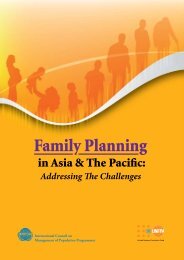Inter-lInkages between PoPulatIon DynamIcs anD DeveloPment In ...
Inter-lInkages between PoPulatIon DynamIcs anD DeveloPment In ...
Inter-lInkages between PoPulatIon DynamIcs anD DeveloPment In ...
You also want an ePaper? Increase the reach of your titles
YUMPU automatically turns print PDFs into web optimized ePapers that Google loves.
Table 2: <strong>In</strong>cidence of poverty by spatial distribution and regions1999 2007Malaysia Urban Rural Malaysia Urban Rural<strong>In</strong>cidence of poverty 8.5 3.3 14.8 3.6 2.0 7.1<strong>In</strong>cidence of hardcore poverty 1.9 0.5 3.6 0.7 0.3 1.42004 2007PeninsularMalaysiaSabahSarawakPeninsularMalaysiaSabahSarawak<strong>In</strong>cidence of poverty 3.6 23.0 7.5 2.3 16.0 4.2Sources: EPU, Malaysia. 2008. Mid-term Review of the Ninth Malaysia Plan 2006-2010. Putrajaya: Prime Minister’s Department.The data served as input for policy formulation pertaining to poverty eradication programmes such as:• Determine the baseline for assistance to be given to the poor according to state, rural/urban and householdsize. The poverty line income (PLI) varies by states and rural/urban areas. For instance, the average PLIfor 2007 for Peninsular Malaysia was RM720; Sabah was RM960; and Sarawak was RM830. As forhardcore poverty, the PLIs were RM430, RM540 and RM520, respectively. Different sets of PLIs wereused for the urban and rural areas;• Provide assistance to low income households. The programmes are funded by the federal government andimplemented by the state governments; and• Provide input to ministries/agencies involved in poverty eradication for planning their respective povertyeradication programmes. For example, the MOH would use the data to plan for welfare and/or subsidise/waive payment for the poor who sought treatment or health care services from public health care institutions.<strong>In</strong> the Ninth Plan, the programmes planned are target specific, in terms of target groups and location, toensure that they are sustainable and achievable. The target groups are households with mean monthly grosshousehold income below the PLI.The programmes are mainly ‘income generating and employment opportunities’ oriented as opposed to ‘givingoutright assistance’ oriented. The latter approach is mainly for target groups such as the elderly, poor singleparents, the handicapped and destitute who are unable to work for an income. On the other hand, the formerapproach is to promote human capital development and capacity building among the poor within the workingage group. This is to enable them to participate in more productive economic activities to improve theirquality of life and at the same time inculcating and reinforcing positive values such as good work ethics andself-confidence. This will ensure greater impact and sustainability of the programmes.The major programmes available are:• Amanah Ikhtiar Malaysia, an NGO that provides micro-credit loan;• Skim Pembangunan Kesejahteraan Rakyat programmes, which focus on economic and social projects -such as income-generating projects, education and training, housing assistance and human capitaldevelopment - involving the poor;• Yayasan Basmi Kemiskinan, a state-based foundation that provides financial and non-financial assistanceto poor households for income generating activities;• Support programmes such as provision of textbooks, scholarship and allowance, supplementary food, andhostels accommodation for students from poor families to increase access of poor households to educationand training; and• Housing projects under the Program Perumahan Rakyat to provide better housing facilities for low incomepopulations.29














